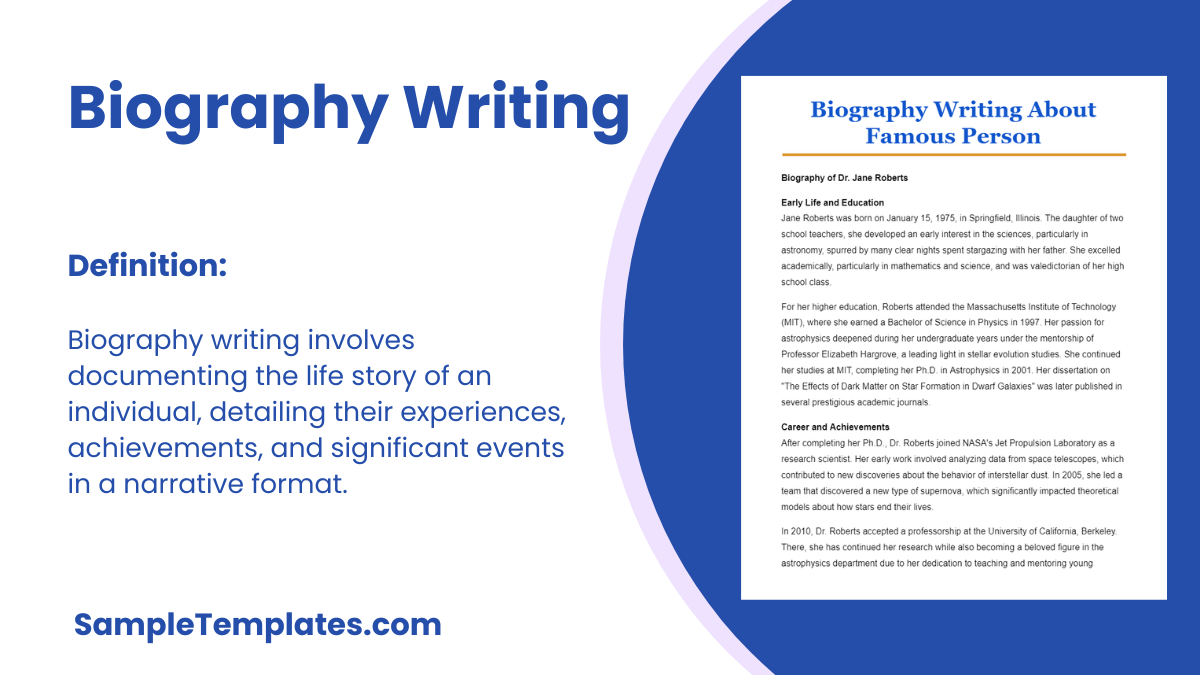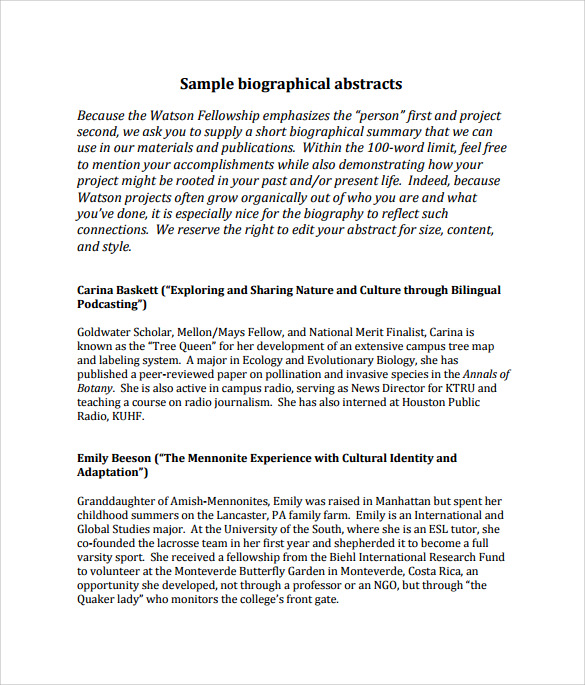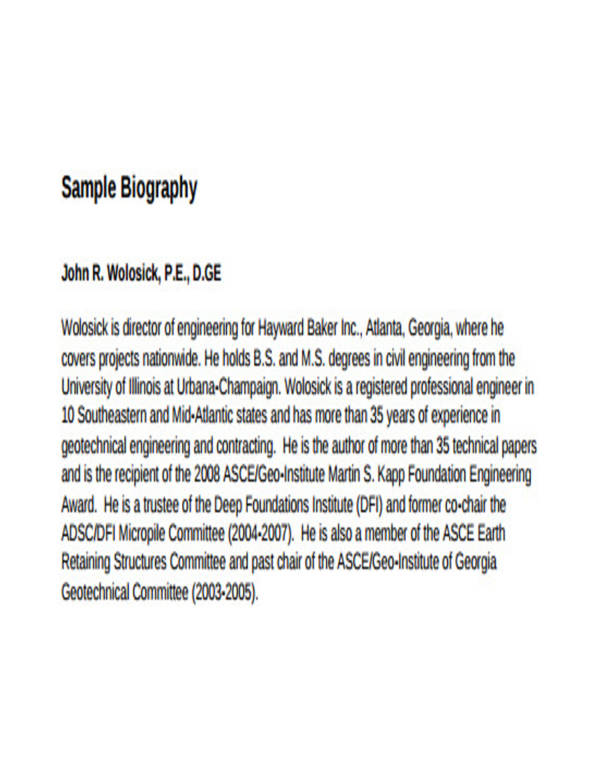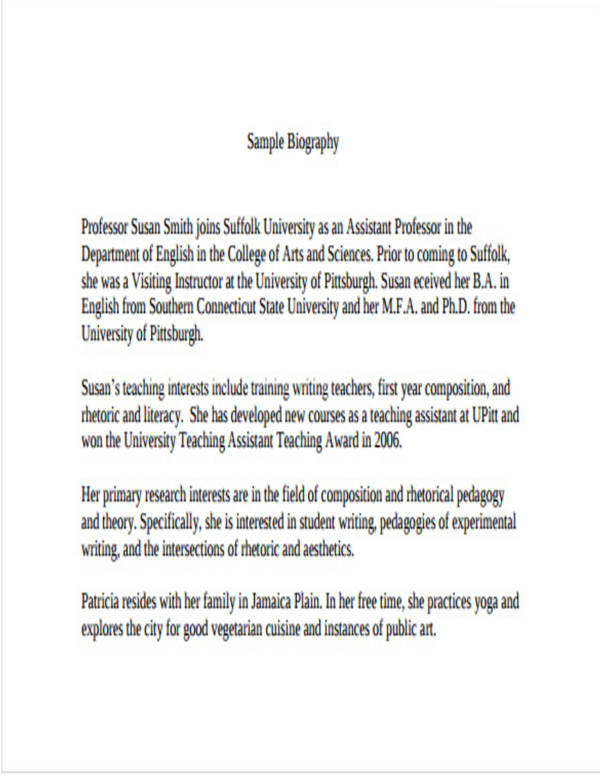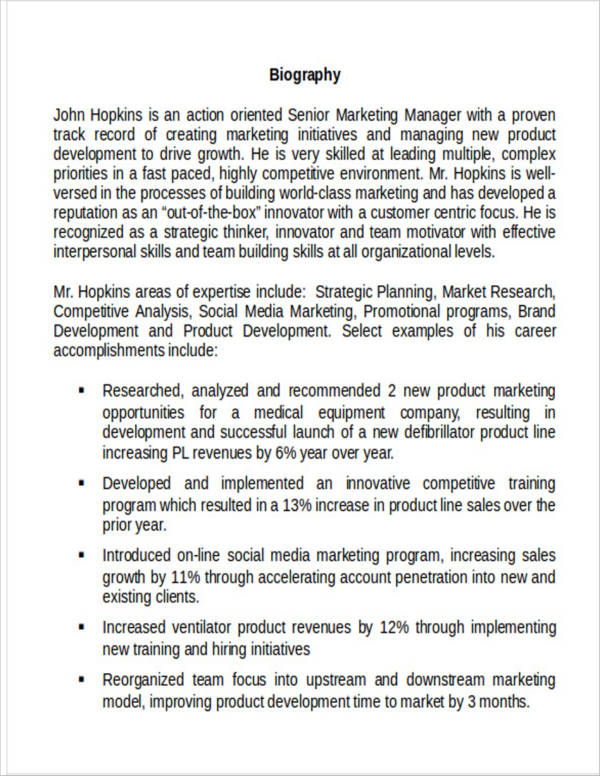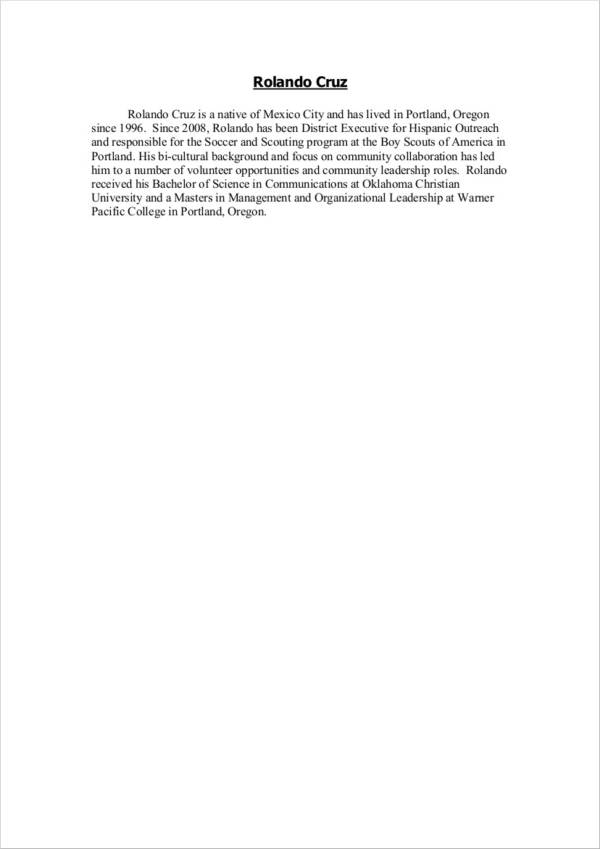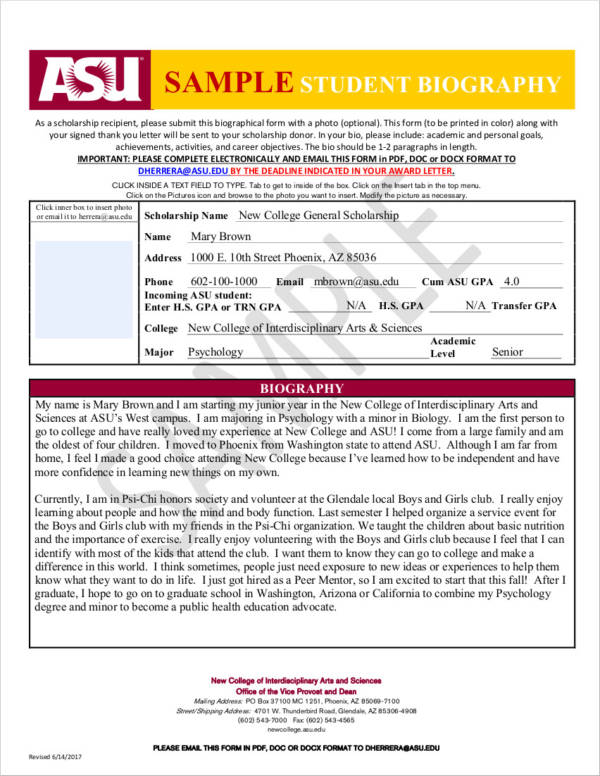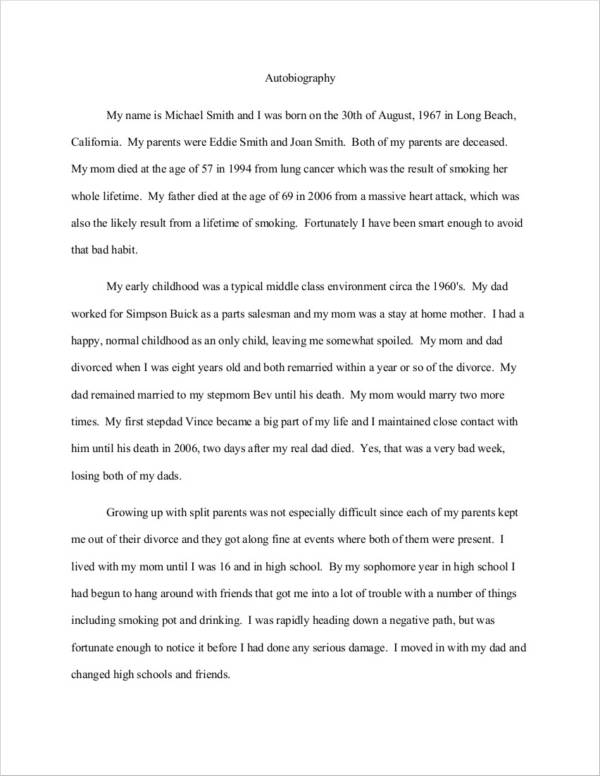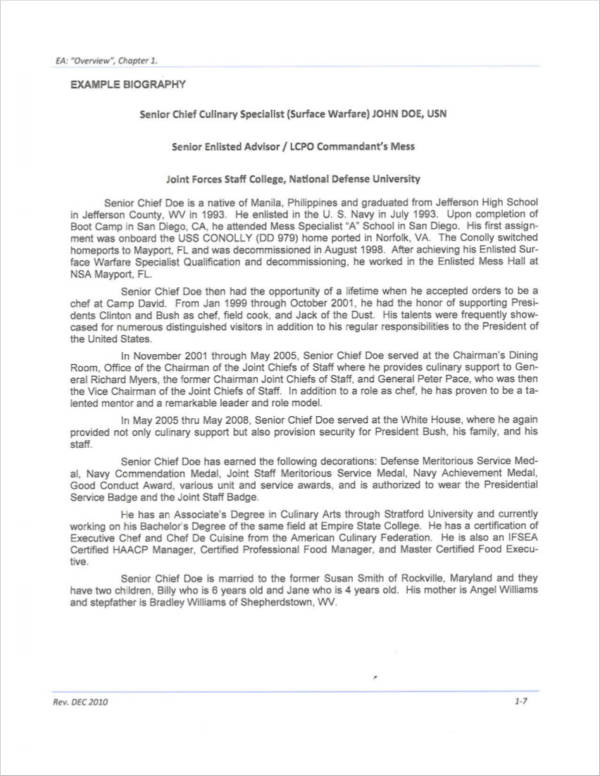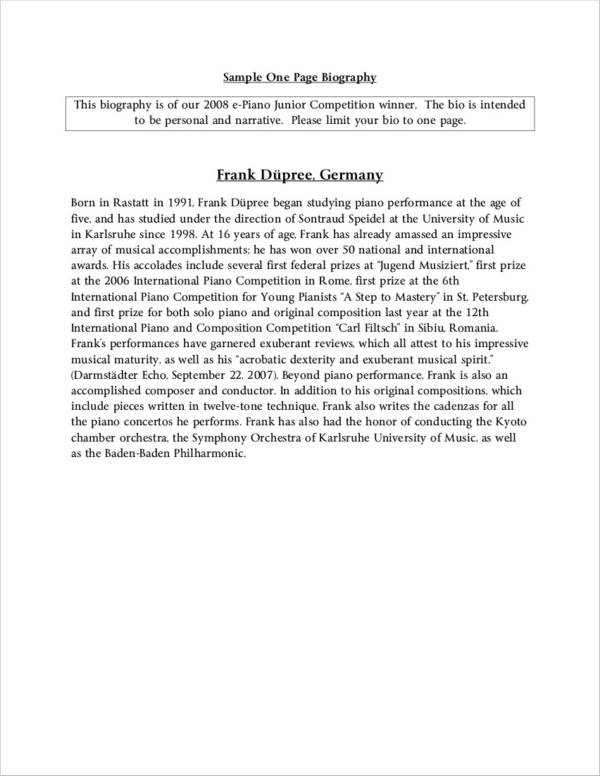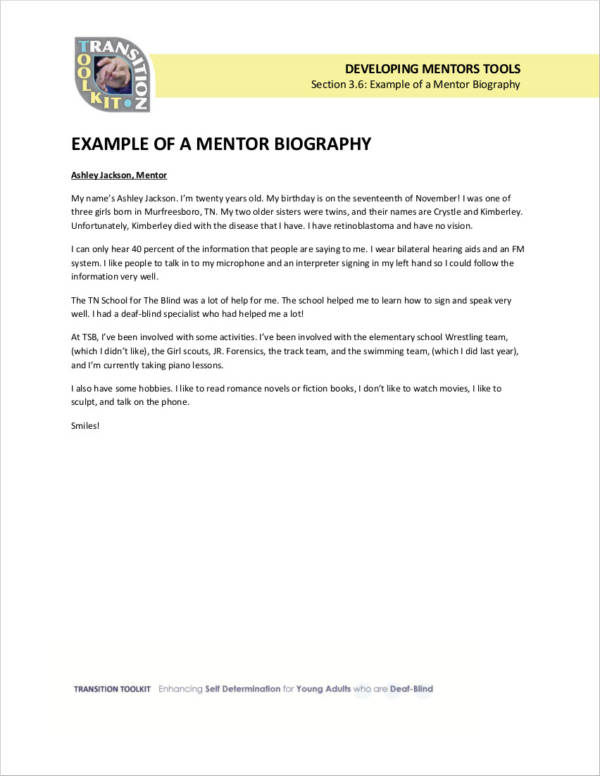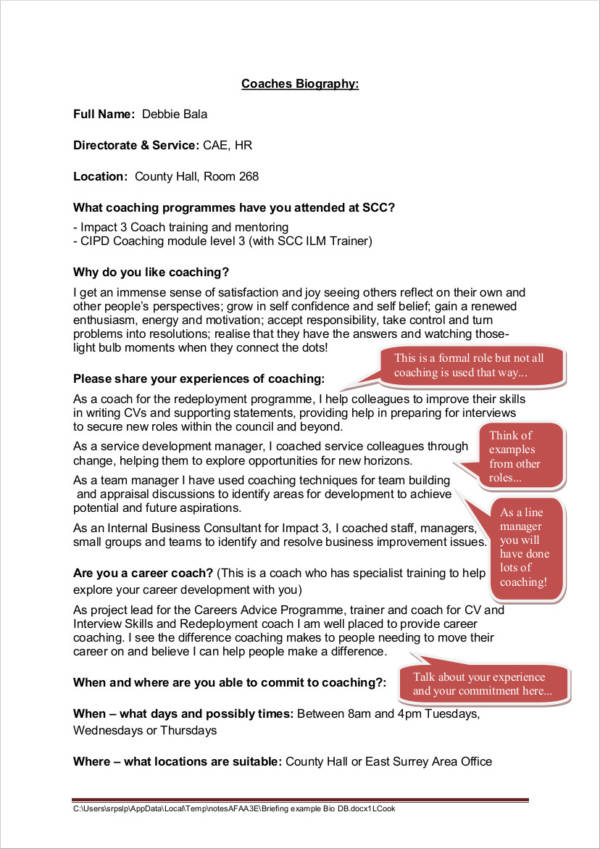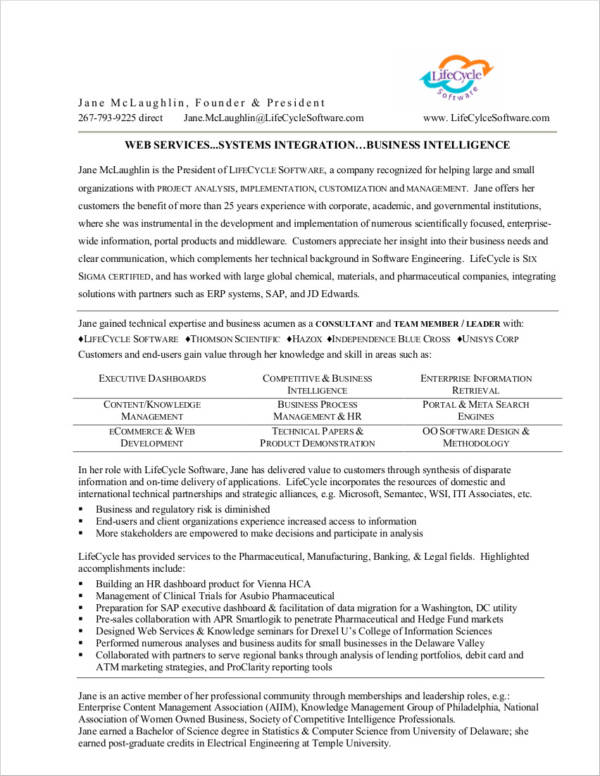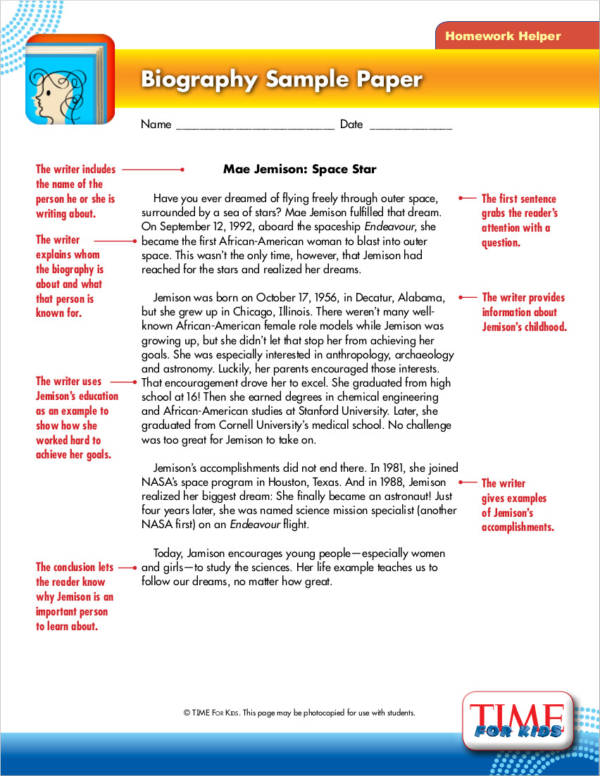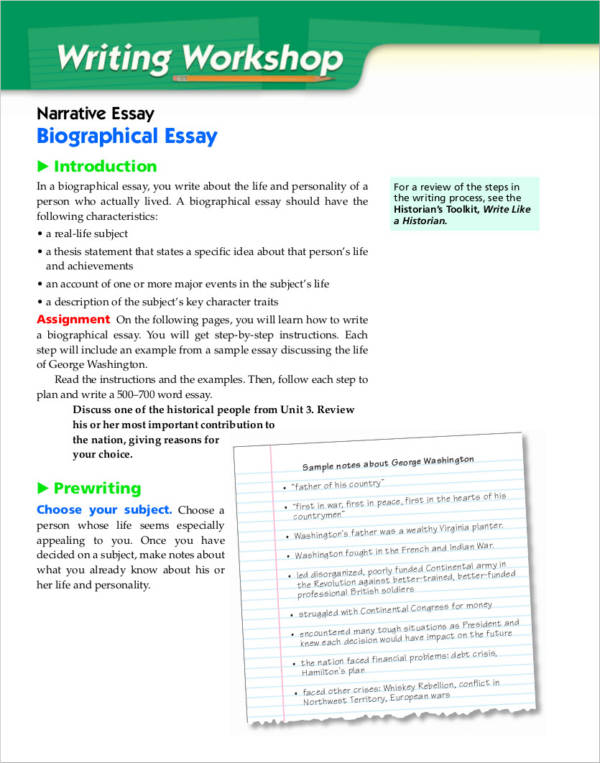At least once in your life, you will be asked to write a biography either for a school requirement or writing for fun. You may find it as a challenge but for sure, it will be something that will pique your interest as you will learn a lot about a person by writing a biography. You may also see free writing samples.
- Is this the first time that you are writing a biography? Do you need to refresh your memory on how to come up with a good one? We are here to help you out! We have a few guidelines that you can easily follow and we also have a couple of biography samples that would be great sample references to give you a good idea about what you should be including in your biography write-up. If you are ready to learn more about biography writing, then you should definitely keep reading this article. Let’s go!

Download Biography Writing Bundle
Biography Writing For Students
[Biography of Jane Goodall]
Early Life
Jane Goodall was born on April 3, 1934, in London, England. From a young age, Jane was fascinated by animals and nature. She loved to observe birds and animals, spending hours in her garden or on family holidays at a farm. Her favorite toy was a stuffed chimpanzee named Jubilee, which sparked her early interest in animals.
Education and Early Career
Jane was an average student in school because she preferred being outdoors and learning about wildlife rather than staying inside the classroom. Despite her lack of interest in traditional schooling, her passion for animals and nature continued to grow. At the age of 18, she left school and worked as a secretary and later as a filmmaker to save money for a trip to Africa.
Journey to Africa
In 1957, at the age of 23, Jane visited a friend in Kenya. She was thrilled to be on the continent she had dreamt of so often as a child. During her visit, she met the famous anthropologist and paleontologist Dr. Louis Leakey. Leakey believed that a long-term study of chimpanzees in the wild would provide important insights into human evolution. He was impressed by Jane’s enthusiasm and her knowledge of Africa’s wildlife, and he hired her to study chimpanzees at the Gombe Stream Reserve in Tanzania.
Groundbreaking Research
Without any formal training in scientific methodology, Jane began her study of the chimpanzees in Gombe in 1960. She made groundbreaking discoveries that would change the way humans viewed animals. She observed chimpanzees making and using tools—a trait that scientists had thought was exclusive to humans. She also noted that chimpanzees had complex social behaviors and emotional lives, showing care and affection within their families much like humans do.
Contributions and Legacy
Jane Goodall’s work has significantly impacted our understanding of primates and has led to greater awareness and advocacy for wildlife conservation. She founded the Jane Goodall Institute in 1977, which supports research at Gombe and works for conservation and animal welfare globally. Goodall has also been a global leader in advocating for environmental stewardship, urging people to live sustainably to protect the planet for future generations.
Awards and Honors
Jane Goodall has received numerous awards and honors for her scientific achievements and her conservation efforts, including being named a Dame Commander of the Order of the British Empire. Her work continues to inspire students and adults alike to take an active interest in conservation and to treat all living beings with respect and empathy.
Conclusion
Jane Goodall’s lifelong dedication to her research and her tireless efforts in conservation demonstrate how one person’s passion can change the world. Her story is an inspiration, showing that with curiosity and determination, anyone can make a difference in the world.
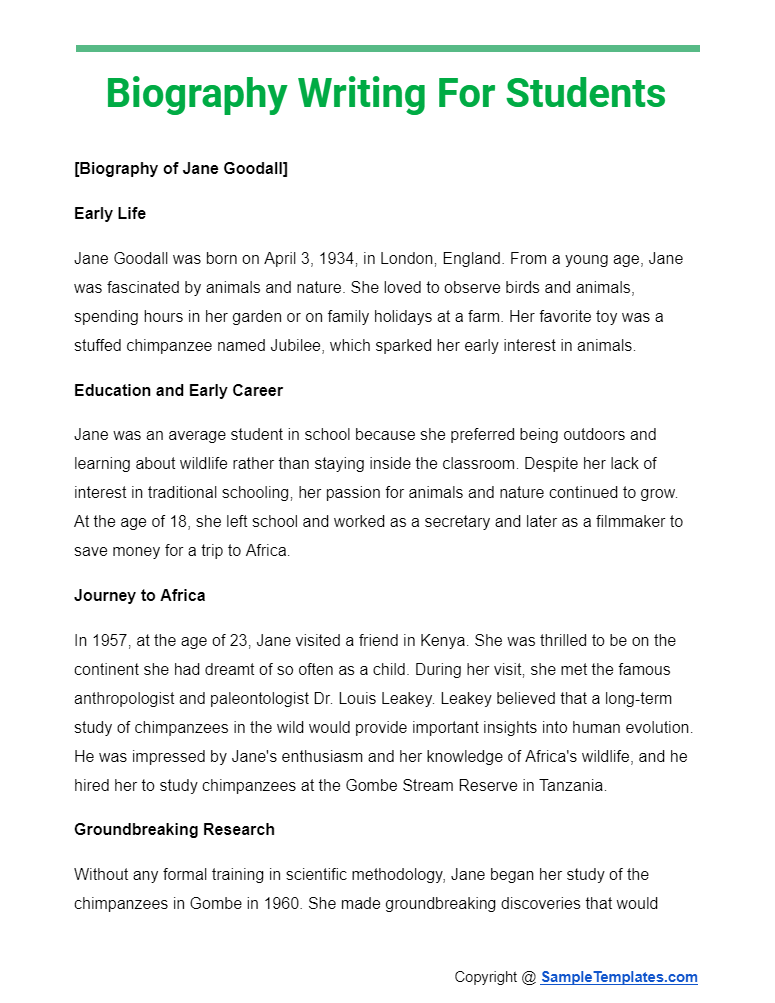
Biography Writing About Myself
[Your Full Name]
Early Life and Education
[Your Full Name] was born on [Date of Birth] in [Place of Birth]. Growing up in [City or Town], [Your Name] showed an early interest in [mention any early interests relevant to what you do now]. Attending [Name of High School], [he/she/they] excelled in [mention notable subjects or activities]. [Your Name] furthered [his/her/their] education at [Name of College or University], earning a degree in [Your Degree] in [Year].
Career
[Your Name] began [his/her/their] professional career at [Name of First Company], where [he/she/they] worked as a [Your First Job Title]. Here, [Your Name] developed [mention any critical skills or experiences]. After several years, [he/she/they] moved to [Name of Next Company or Next Position], where [he/she/they] [describe what you achieved or learned there]. Over the years, [Your Name] has gained extensive experience in [Your Field], specializing in [Your Specialty].
Throughout [his/her/their] career, [Your Name] has been recognized for [mention any awards, honors, or recognitions]. [His/Her/Their] work has notably impacted [mention any significant contributions or changes in your field or community].
Philanthropy and Personal Interests
Aside from [his/her/their] professional life, [Your Name] is actively involved in [mention any charitable work, community service, or hobbies]. [He/She/They] is passionate about [mention what you are passionate about], which has led [him/her/them] to volunteer for [mention any organizations or causes you support].
Current Projects and Future Goals
Currently, [Your Name] is [describe what you are working on professionally and any personal projects]. Looking ahead, [he/she/they] aims to [describe your goals or aspirations].
Personal Life
[Your Name] resides in [Your City of Residence]. In [his/her/their] free time, [he/she/they] enjoys [mention hobbies or interests].
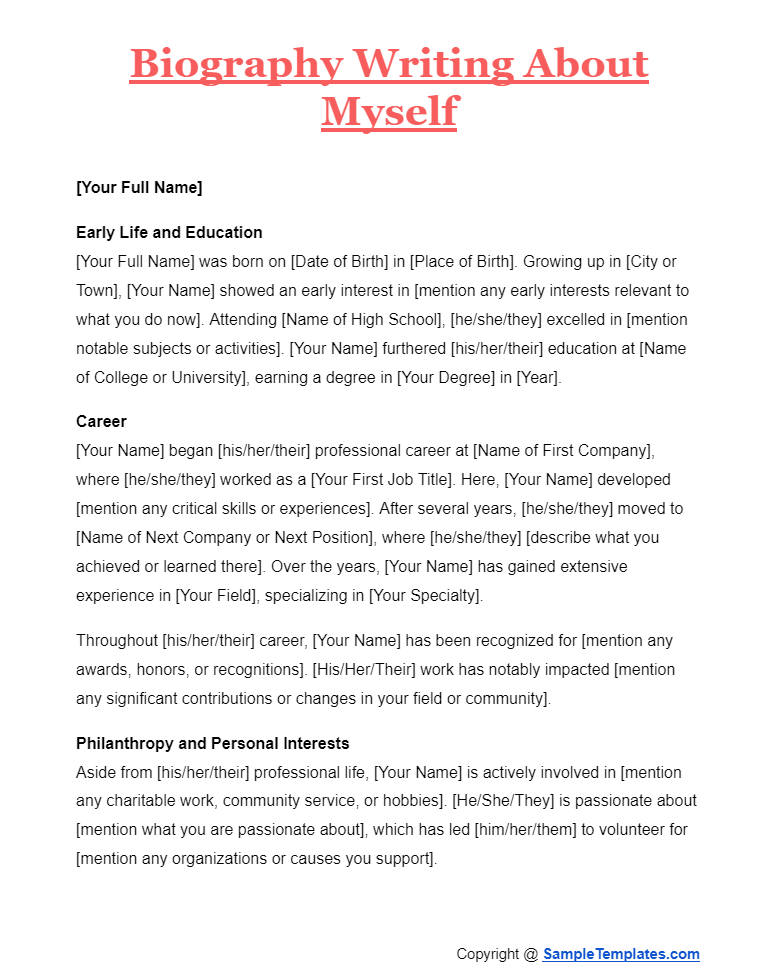
Biography Writing About Famous Person
Biography of Dr. Jane Roberts
Early Life and Education
Jane Roberts was born on January 15, 1975, in Springfield, Illinois. The daughter of two school teachers, she developed an early interest in the sciences, particularly in astronomy, spurred by many clear nights spent stargazing with her father. She excelled academically, particularly in mathematics and science, and was valedictorian of her high school class.
For her higher education, Roberts attended the Massachusetts Institute of Technology (MIT), where she earned a Bachelor of Science in Physics in 1997. Her passion for astrophysics deepened during her undergraduate years under the mentorship of Professor Elizabeth Hargrove, a leading light in stellar evolution studies. She continued her studies at MIT, completing her Ph.D. in Astrophysics in 2001. Her dissertation on “The Effects of Dark Matter on Star Formation in Dwarf Galaxies” was later published in several prestigious academic journals.
Career and Achievements
After completing her Ph.D., Dr. Roberts joined NASA’s Jet Propulsion Laboratory as a research scientist. Her early work involved analyzing data from space telescopes, which contributed to new discoveries about the behavior of interstellar dust. In 2005, she led a team that discovered a new type of supernova, which significantly impacted theoretical models about how stars end their lives.
In 2010, Dr. Roberts accepted a professorship at the University of California, Berkeley. There, she has continued her research while also becoming a beloved figure in the astrophysics department due to her dedication to teaching and mentoring young scientists. Her current research focuses on searching for exoplanets in habitable zones, which could potentially support life.
Major Publications and Awards
Dr. Roberts has authored or co-authored over 100 peer-reviewed articles in scientific journals. Her book, “Stars and Beyond: Gateway to Understanding the Universe,” published in 2015, became a bestseller and has been translated into twelve languages.
Her contributions to astrophysics have been recognized with numerous awards, including the American Astronomical Society’s Helen B. Warner Prize for Astronomy in 2008 and the National Medal of Science in 2019.
Personal Life
Outside of her academic pursuits, Dr. Roberts is an avid hiker and amateur photographer. She lives in Berkeley with her husband, David, a mechanical engineer, and their two children.
Legacy and Continuing Impact
Dr. Roberts is widely regarded as one of the leading astrophysicists of her generation. Her work continues to influence both theoretical understanding and practical applications in space exploration and cosmology. She remains active in research and public outreach, committed to inspiring the next generation of scientists.
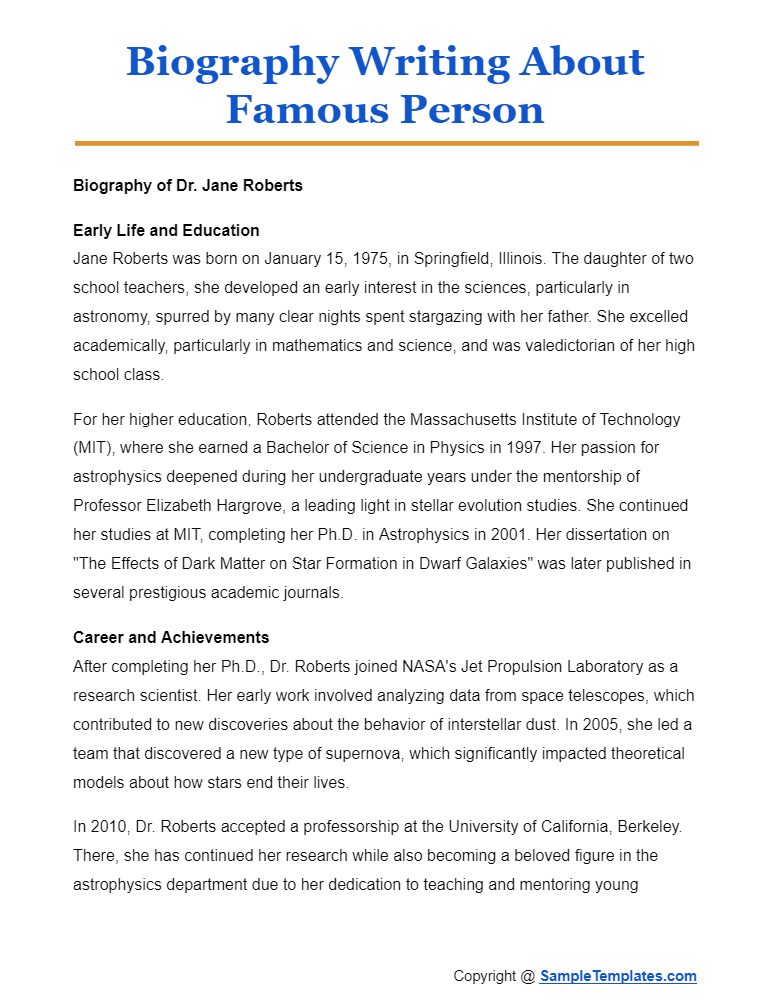
Biography Writing For Kids
Marie Curie: The Pioneer of Radioactivity
Marie Curie was a brilliant scientist who made groundbreaking discoveries in the field of radioactivity. She was born on November 7, 1867, in Warsaw, Poland, and her full name was Maria Sklodowska. Even as a young girl, Marie was very curious about the world around her and loved learning.
Early Life and Education
Marie grew up in a family that valued education highly. Her father was a teacher of mathematics and physics, which inspired Marie’s interest in science. However, in Poland at that time, women were not allowed to attend university. Determined to pursue her education, Marie moved to Paris, France, where she enrolled at the Sorbonne University. She studied physics and mathematics, graduating at the top of her class.
Discoveries and Achievements
In Paris, Marie met another scientist, Pierre Curie, and they got married. Together, they conducted research on radioactive materials. Marie discovered two new elements, polonium and radium, which were much more radioactive than uranium. Her work was so important that she won the Nobel Prize in Physics in 1903, alongside her husband Pierre and another scientist, Henri Becquerel. This made her the first woman to ever win a Nobel Prize!
Later Work and Second Nobel Prize
After Pierre’s tragic death in 1906, Marie continued her research alone. She made significant advances in the use of X-rays in medicine, especially during World War I, when she helped set up mobile X-ray units to treat wounded soldiers. In 1911, Marie Curie won a second Nobel Prize, this time in Chemistry, for her work with radium and polonium. She remains the only person to have won Nobel Prizes in two different scientific fields.
Legacy
Marie Curie’s discoveries have had a lasting impact on science and medicine. She showed the world the importance of women in science and inspired many future generations to pursue scientific careers. She passed away on July 4, 1934, from an illness caused by prolonged exposure to radiation, a risk she faced because of her groundbreaking work.
Marie Curie’s life is a testament to the power of curiosity, hard work, and dedication. Her contributions to science have saved countless lives and continue to influence scientific research today.
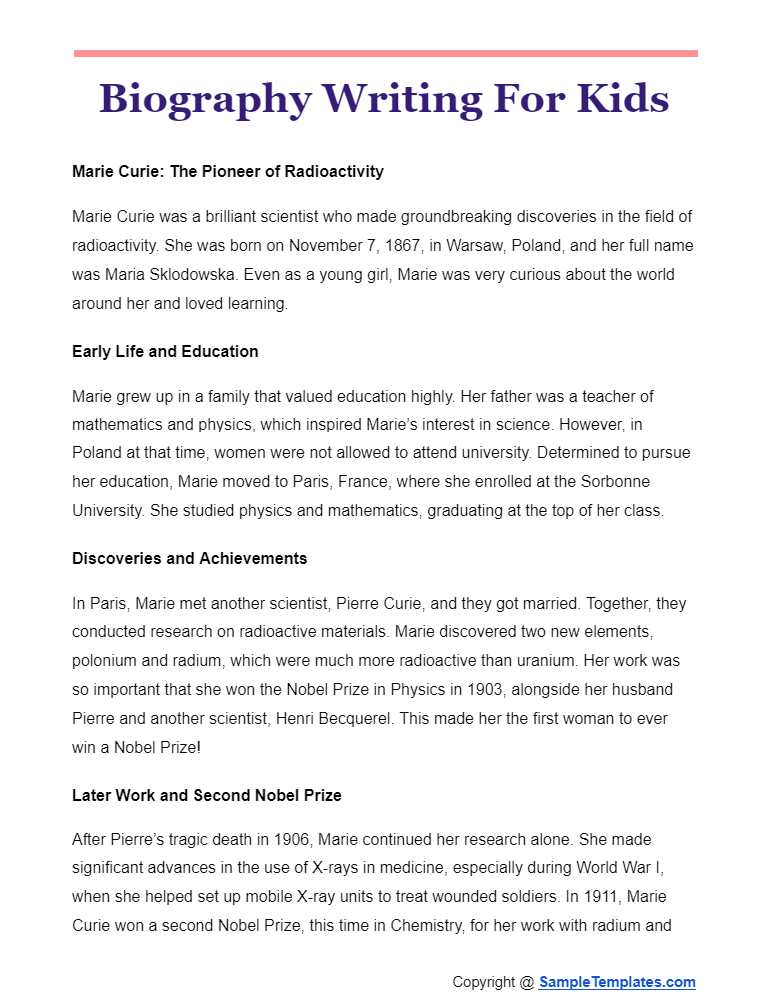
Browse More Templates On Biography Writing
Sample Professional Biography Outline Template
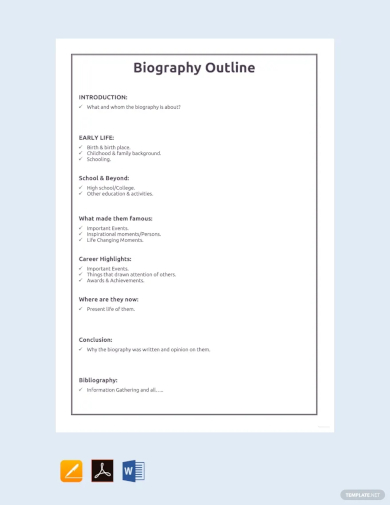
Biography Report Outline Template
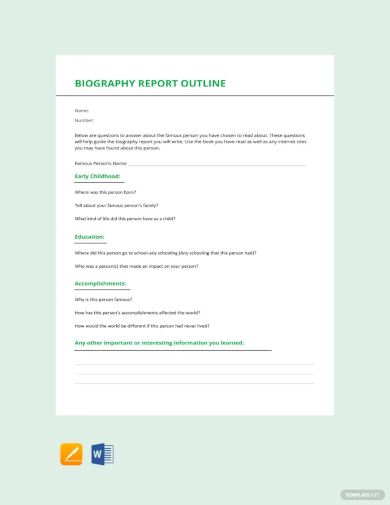
Formal Biography Worksheet Template
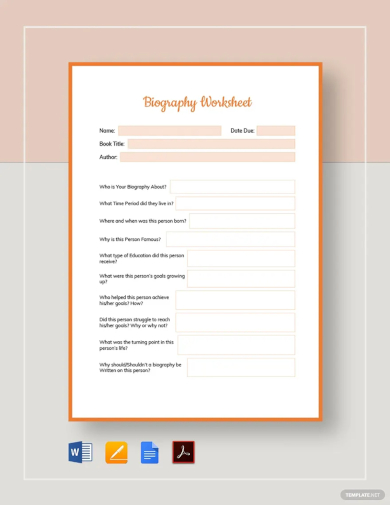
Short Biography Outline Template
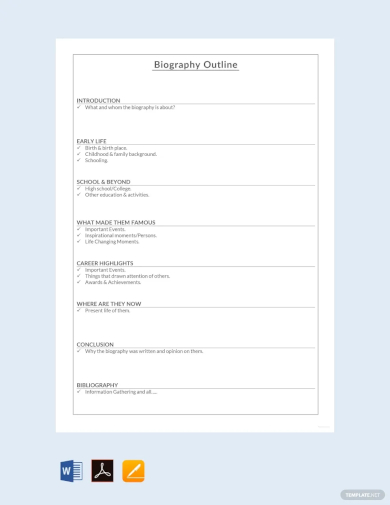
Personal Biography Outline Template
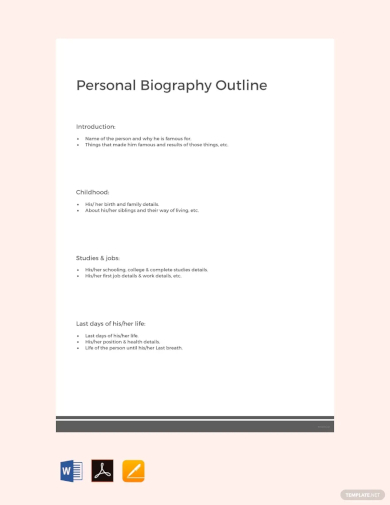
Sample Artist Biography Outline Template
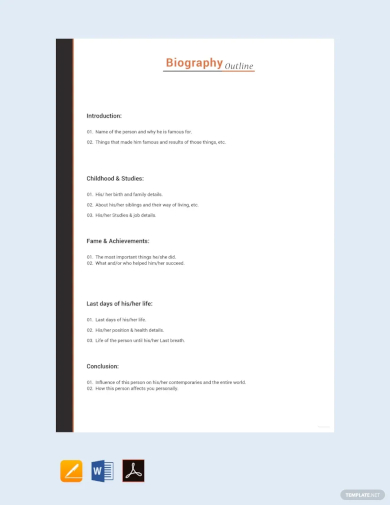
Title of Biography Outline Template
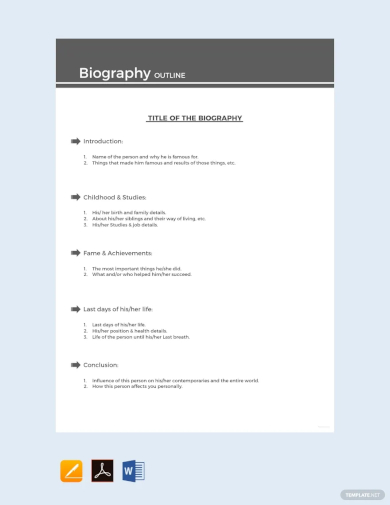
Biography Report Outline Template

Sample Character Biography Outline Template
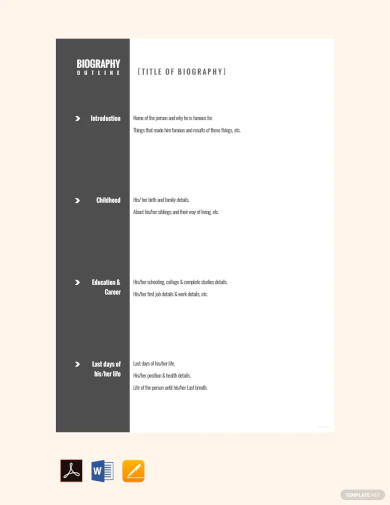
Biography Outline Template For Elementary Students Template
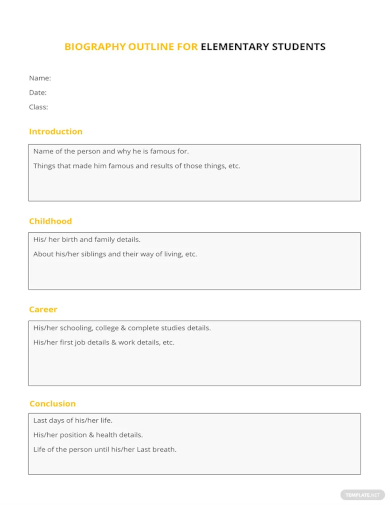
Biography Report Template
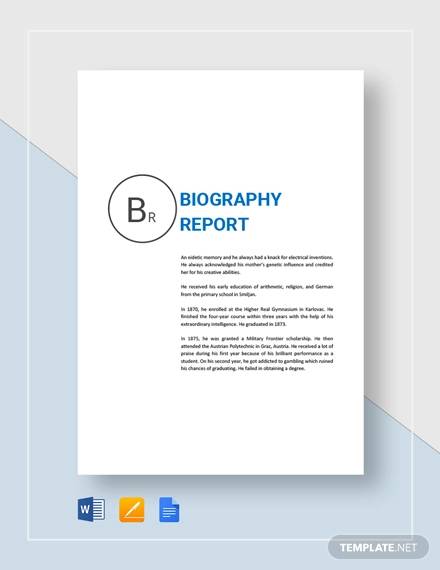
Basic Biography Example
Biography Example in PDF
Standard Biography Template
Printable Biography Example
Short Biography Template
Sample Student Biography Form Template
Sample Autobiography Template
Formal Biography in PDF
How to Write a Biography?
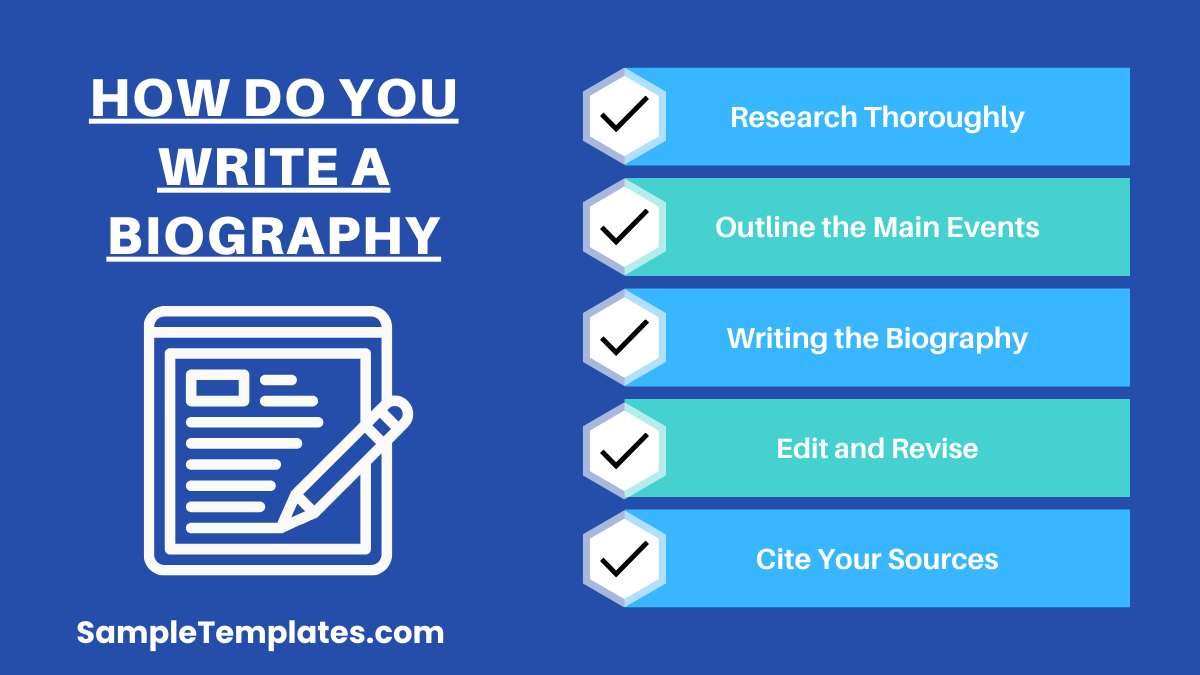
When it comes to writing a biography, it can be a fun and challenging task altogether. You might be writing a biography for a class paper or you might also be writing it to practice your writing skills. Once you already have a good idea about who you will be writing about, do an in-depth research about him/her and start writing the biography. You may also like biography report templates.
In this section of our article, we will let you in on a guideline regarding how to write a biography.
1. Researching the Subject of Your Biography
Research, when it comes to biography writing, is of high importance. You want to make sure that you will be able to get all of your facts straight and that you do not want to miss a single detail about your subject. Here are some tips on how you can make a proper research about the subject of your write-up. You can also check out useful writing templates.
- Ask for permission. You have to ask to make sure that your subject is okay with you writing about his/her life. You can ask permission in person by setting a meeting with your target subject or you can send a formal letter or email to the subject asking him/her to be the subject of your biography write-up. However, if your target subject is no longer living, you obviously do not need to ask for permission to write about them.
- Prioritize primary sources. Primary sources would include books, letters, articles, autobiographies, and of course, interviews. You can find written sources from the library and even the Internet. Research as much as you can about the subject. You may also see book writing samples.
- Interviews. When it comes to interviews, you have to make sure that you are able to interview the subject in person if possible. You may also opt to interview people who are close to the subject. Prepare your interview questions ahead and bring with you a device that is capable of recording the conversation that you have with the subject or people close to them. Do not be afraid to ask for multiple interviews until you get all of the information that you would need for your write-up.
- Feel the subject’s history. To gather a few supplemental information about the subject, you can visit some of the places that are relevant to the subject to get a better feel of his/her history. By being where the subject has been, you can get an idea of how the subject has felt. You can also check out speech writing
- Create the timeline of the subject. By making use of timeline templates, you will be able to easily map out what the chronological order of the events in the subject’s life is. You can highlight the year of big events or moments by using a timeline. You can check out Sample Biography Timelines to get a hold of great timeline templates that are high in quality.
2. Getting Started on Your Biography
Now that you have done your research, it is now time for you to start writing that biography. Check out the tips that we have for writing a biography.
- Write in a chronological manner. You should start with the subject’s birth and childhood, followed by teen years and adulthood. Make sure to focus on the subject’s most memorable moments and achievements during his life and include information about his/her death if the subject is no longer alive or what his/her future plans are should the subject be still alive. You may also like script writing samples.
- Start with your main idea. Introduce the subject properly. For example, your subject has made a great impact on lessening a community’s carbon footprint, you can introduce him/her like so:
- John Smith, an environmentalist, has successfully lessened Community A’s carbon footprint by 85% in 2009. Since then, he has led 20 more communities with lessening their carbon footprint and making the world more eco-friendly.
- Make use of flashbacks. Use the flashback as a means of successfully discussing the achievements that the subject had in the past. Flashbacks should be written in detail and should also discuss everything appropriately. If you are shifting from present-day setting to flashbacks, make sure that your transition statements make everything flow smoothly. You may also see summary writing
- Talk about the achievements and milestones. By talking about these things, you give your reader a sense of what was considered by the subject as important moments in his/her life, why it mattered to him/her, and how it affected his/her life. You can also check out essay writing
- Take a look at any pattern. More or less, when you start writing the biography, you will find yourself seeing a pattern in what the subject has done in order to reach what he/she has achieved.
- Include your thoughts on the matter. A short personal essay regarding the matter would be great to insert in your biography report templates. Reflect on the data that you have gathered and place your thoughts near the end of your paper.
3. The Finishing Touches
Now you are done writing the biography. Congratulations! But we are not yet done, though. We should review and polish our biography first before we turn it in for submission or publishing. Here are a few ways of how you can polish your biography paper. You may also like writing thank-you notes.
- Proofread. This should be the first thing that you do after you finish writing your biography. Print out a copy of your biography and mark any errors in spelling and grammar that you might find in your paper.
- Ask someone to give feedback. Who better to ask than your teacher or someone who is experienced with writing biographical write-ups, right? You can even ask a friend. Ask for feedback that would help to make your biography essay look better and sound better. You can also ask them to check any punctuation and misspellings as well as any grammatical errors that you might have missed. You may also see dos in writing your self-evaluation.
- References. Do not forget to acknowledge any references you might have. You can make use of APA paper format.
If you are finding that you are constantly rearranging statements, that is alright! If it makes your write-up look a whole lot better, then you should definitely do what you feel should be done.
One Page Biography Template
Mentor Biography Format
Sample Instructor Biography Template
Coaches Biography Template
Entrepreneur Biography Outline Template
Five Parts of a Biography

Writing a biography requires a structured approach to ensure that all relevant aspects of a person’s life are covered comprehensively. Typically, a biography is divided into five key parts:
1. Introduction
- Overview: This section introduces the subject of the biography, including their name, significance, and a brief summary of their most notable achievements.
- Hook: It often starts with a hook to grab the reader’s attention, possibly highlighting a pivotal moment or a unique aspect of the person’s life. You can also see more on Professional Biography.
2. Early Life
- Background: This part details the subject’s early years, focusing on their birthplace, family background, upbringing, education, and any formative experiences that influenced their later life.
- Initial Interests: It also explores their early interests and the beginnings of what would become significant later in their life, providing a foundation for understanding their motivations and future actions.
3. Career and Major Accomplishments
- Career Path: Here, the biography delves into the subject’s professional life, significant milestones, and the major contributions they made in their field. This section is often the bulk of the biography, detailing the subject’s work, struggles, successes, and sometimes their failures.
- Impact: The discussion extends to the impact of their work, whether on a specific field, the broader public, or global implications.
4. Personal Life
- Relationships and Family: This segment provides insights into the subject’s personal relationships, including family life, friendships, and significant others. It may explore how these relationships influenced their career and personal happiness.
- Personality Traits: Personal anecdotes and descriptions of their personality traits, values, and beliefs that shaped their decisions and interactions with the world are also highlighted here.
5. Later Life and Legacy
- Final Years: The biography wraps up with a look at the subject’s later years, including how they spent their time after the peak of their career, any ongoing projects, retirement, and ultimately their death.
- Legacy: Lastly, it assesses the legacy left behind, discussing how they are remembered, ongoing influences in their field, and how they have inspired others. This may include mentions of honors, memorials, or continued relevance in various contexts. You can also see more on Biography Research Report.
Additional Considerations:
- Contextual History: Throughout the biography, it’s important to interweave historical and cultural contexts that explain and give depth to the subject’s actions and choices.
- Sources and Citations: A well-researched biography will also include citations from primary and secondary sources to ensure accuracy and provide deeper insights.
These five parts of a biography work together to provide a holistic view of the subject, making their story compelling and informative. This structure helps readers understand not only what the person did but who they were and the impact they had on the world. You can also see more on Biography Timeline.
Biography Paper Template
Sample Biographical Essay Template
So there you have it! Whether you are writing your biography essay for a school requirement or if you are a budding author, writing a biography sample timeline template should be done with utmost care and with patience. You are telling another person’s story, so you want to make sure that you are able to present accurate and factual information. It also has to be fun and engaging to make it an interesting read for your audience. This way it will also make it more memorable to the reader. You can also see more on Memoir.
Sample Planning on writing an autobiography? Have a look at our autobiography samples for a good and high-quality samples and a good guideline on how you can do so.
What makes a good biography?
A good biography is engaging, well-researched, accurate, and provides a comprehensive and balanced view of the subject’s life, achievements, and impact, highlighting personal and professional aspects. You can also see more on Autobiography Outline.
What not to write in a biography?
Avoid including unverified information, excessive personal opinions, irrelevant details, or sensitive personal information that could harm the subject’s reputation or invade their privacy.
What are the 4 elements of a biography?
The four elements are: the subject’s early life, major life events, personal and professional achievements, and the impact or legacy they left behind. You can also see more on Bio Sample.
How long should a biography be?
The length of a biography varies but should be long enough to provide a comprehensive overview, typically between 200 to 2,000 words depending on the depth of coverage.
What are the rules of biography?
Biographies should be factual, respectful, balanced, and well-researched, ensuring accuracy while presenting a truthful and fair portrayal of the subject’s life and achievements. You can also see more on Character Profile.
In conclusion, biography writing requires thorough research and thoughtful narrative to capture an individual’s life and impact accurately. A well-crafted biography provides insight, preserving their legacy for future generations.
Related Posts
8+ Sample Artist Statements
7+ Sample Company Profile Samples
7+ Sample Accounting Balance Sheets
7+ Sample Company Profiles
6+ Sample Child Funeral Program Templates
How to Write a Petition Guide?
How to Write an Application Letter for Employment
35+ Printable Obituary
29+ Sample Cover Letter Example Templates
26+ Free Obituary Templates
14+ Death Notice Samples & Templates
9+ Resume Writing Samples & Templates
9+ Sample Blank Resumes
8+ Sample Career Timeline
7+ Personal Essay Examples
